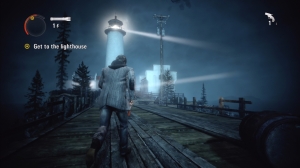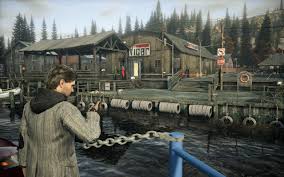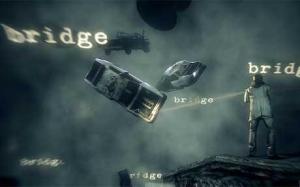In the second episode of Harrison’s Halloween Horror Haul things get a little trippy.
If Outlast is a little too hardcore for you, then Remedy Entertainment’s interesting fusion of horror TV and literature might be more up your street. Unlike the last game that we talked about, Alan Wake is actually rather tame in the frights department. The jump scares are mild and infrequent, the violence is largely implied, and the enemies that you encounter are lacking in any real menace. This is horror intended for the fainthearted that’s for sure, but that doesn’t mean it has no value whatsoever. What the game lacks in intensity, it more than makes up for in style and narrative intrigue. Channelling David Lynch crossed with The Twilight Zone, this is a dreamlike and surreal supernatural thriller, with a palpable atmosphere and effective central mystery.
Released in 2010 to critical acclaim, Alan Wake is a postmodern celebration of everything that its creators hold dear. Twin Peaks, The Shinning, The Birds, Salem’s Lot, The Mist, Blue Velvet; all of these works are either name-checked directly or at least referenced to a certain extent here. The resultant game is an amalgamation of a variety of influences, from mystery television, to horror novels and cult cinema, but it still feels like a cohesive whole in and of itself. Indeed, Alan Wake is certainly one of the most singular games out there, with a distinctive tone and identity that feels unlike anything else. From its striking visuals, to its utterly bonkers plot, to its eclectic soundtrack, it’s a totally unique experience.

The game’s narrative is concerned with the eponymous novelist, who is vacationing with his wife at the small town of Bright Springs. As Wake himself points out, it’s the type of place that you’d assume was extinct, the kind where everyone knows each other and old queer superstitions are still held in high regard. It is a place that Wake is quick to disparage. We almost immediately come to resent the author, he’s anti-social, impatient, stuck-up and has quite the temper on him. Most of his angst seems to stem from the fact that he’s been suffering from writer”s block for several years now, causing him to lash out at his friends and his devoted spouse, Alice. When he discovers that Alice has actually arranged the whole getaway as a ruse, in order to convince him to meet a local therapist who specialises in treating struggling artists, Alan looses control and storms out of their rented cabin. Whilst he is cooling off, he hears Alice’s bloodcurdling scream for help. He subsequently rushes back inside to find his wife, only to see her sinking quickly in a nearby lake. Alan promptly dives into the water in an attempt to save her, but passes out in the dark and murky depths.
He then wakes up in his car, unsure of what has happened or where his wife is. He travels into the imposing, fog drenched forest in search of help, whereupon things get very, very peculiar. Alan soon discovers that strange shadowy creatures lurk in the woods, and that a supernatural force is controlling his every move. The plot thickens even more, when Alan comes across an unfinished manuscript for a novel that he supposedly worked on, but doesn’t recall writing. Said manuscript seems to have a prophetic quality, as every word written on the page describes upcoming events with startling accuracy. The weird stuff still doesn’t stop there either, as Alan also realizes that an entire week has gone by since Alice went missing, even though it only just happened. From there, a convoluted story is slowly and deliberately woven, involving other realities, a kidnapping plot, local crazies, and a floating man in a diver’s suit. No, I’m not making this up.
To be honest, condensing this elaborate narrative into a brief summary is nigh on impossible. Each ‘episode’ of the game introduces new elements and twists, so that just when you think you’ve finally got a handle of what’s going on, a new spanner will be thrown into the works, leaving you utterly bewildered. Say what you want, but you can’t fault the ambition of the storytelling here. It’s reminiscent of early era Lost, where you’re thoroughly confused and hooked at the exact same time. You’ll find yourself blasting through the game just to get answers and see where it’s all heading, and if you pay close enough attention, you might just leave feeling satisfied.

What’s unique about this particular mystery, when compared to say Twin Peaks or Blue Velvet, is that the amount of information you receive is totally dependent upon you as a player. Vital clues and pieces of exposition are hidden in the form of the elusive manuscript pages, which makes the usually tedious task of hunting down collectables far more appealing. Meanwhile, if you interact with certain characters during the exploratory sections of the game, they might elaborate further upon some things, and of course replaying levels is almost a necessity in order to get the full picture. How much ofAlan Wake remains unexplained is down to how you play, but either way you have to work with it if you want to make complete sense of the whole thing. Like Donnie Darko, It doesn’t hold your hand or spell things out for you and even when you have all the cards on the table, certain things are left open to interpretation.
It makes for a compelling storyline, and one that is told in a unique way, with the game being split up into ‘Episodes’, despite being released as a full product. Whilst this may seem like an odd creative decision, it kind of works. Each instalment has it’s own specific focus and objective, as well as a key theme at the centre. This division helps to structure the story in a clear-cut way, and I especially like the way that each episode ends with a nail-biting cliffhanger (meanwhile the ‘previously on’ segments really do help to provide some kind of orientation for the player in the confusing narrative). The episodic structure thus works for Alan Wake, even if it might initially seem like a showy stylistic choice that serves no purpose.

Indeed, there are plenty of unusual things about Alan Wake that are ostensibly weird for weird’s sake, but actually have a specific function. Take ‘Night Springs’ for example, the black and white sci-fi show that exists within the world of the game. Whilst playing, you can find TVs playing re-runs of this Twilight Zone parody and can then watch the whole thing. Doing so offers nothing in the way of narrative relevance. There’s no explicit connection between ‘Night Springs’ and the events occurring in Bright Falls, however it is a fun little addition. Moreover, each episode’s thematic content in some way correlates to the main narrative. For example, we have episodes dealing with other universes, dreams, ancient Gods, creators rewriting reality and people coming to terms with the fact that they are nothing but characters in someone else’s story. All of these are common themes shared by both ‘Night Springs’ and Alan Wake, and the former does a good job of exploring them in further depth.
The unconventional choices don’t stop there; there are whole sequences of the game where you do nothing but walk around talking to characters in broad daylight, which is hardly typical of an unrelenting horror game. Elsewhere, there’s the distinctive use of licensed music- which brings together various genres, periods and styles to form a very diverse collection of songs. The one thing that seems to unify the music choices here is that all of the songs are seemingly standard pop or rock tracks, that have a haunting or ethereal quality when used in the right context. In particular, Roy Orbison’s ‘In Dreams’ (which famously plays in Blue Velvet) has a sorrowful, creepy and almost operatic quality that fits the game like a glove. There aren’t any other horror games that use their soundtracks like this, which is understandable, because it shouldn’t work. But it does. In fact, it works fantastically.
Even something as straightforward as combat is rendered a little bit different in Alan Wake. Here, your supernatural foes are impervious to bullets and other forms of damage, unless they are exposed to light. This makes encounters far more creative, as Alan must use everything from flares, car headlights, torches and the environment itself to fend off the dark forces at play. It creates so many unique moments, such as the time when you have to stay in a helicopter search light in order to remain unharmed, or the bit where you get to take advantage of an old rock concert set up, so that you can hold off a horde of attackers. Can you name another release that so brilliantly merges an aesthetic element (in this case lighting) with gameplay mechanics?

Of course, Alan Wake isn’t perfect by any stretch of the imagination. If it were, I wouldn’t need to write this piece recommending it in the first place. Unfortunately, there are some areas in which the game design really lets the overall product down. Strangely enough for a game that takes so many risks, it’s actually the more conventional aspects of gameplay that it seems to struggle with. For example, both shooting and driving feel awkward and clunky, which is frustrating when so much of your time requires you to be doing these things. Similarly, things get very repetitive after a while, and the initial novelty of the combat mechanics start to wear off after the 200th time that you’re ambushed in the woods.
It also feels like the story can’t maintain its sense of mystery throughout, as the second half of the game gives way to a much more conventional horror narrative and the dreamlike tone of the earlier sequences is lost in favour of something much more schlocky. There is indeed a tonal shift at around episode 5, at which point everything weird and special about Alan Wake almost instantly disappears. It’s the point where Stephen King and David Lynch are disappointingly traded in for generic survival horror tropes. Finally, there’s the aforementioned fact that, for a horror game, it’s not scary in the slightest. Don’t get me wrong, it has atmosphere down to a T, but I’ve played first person shooters with more scares than this.
Nevertheless, Alan Wake is a glorious experiment that really deserves more attention. Whilst it might fumble in the gameplay department from time to time, it has so much personality and does so many interesting, daring and unique things, with almost all of them pays off. Featuring a killer narrative, top quality world building, and a distinctive style, Alan Wake may not be the scariest horror game out there, but it is still one of the best.
RECOMMENDATION: FOR THOSE OF A MORE NERVOUS DISPOSITION, ALAN WAKE IS AN ENGAGING PSYCHOLOGICAL THRILLER, WITH A FASCINATING STORY AT ITS CORE.
RATING: 8/10